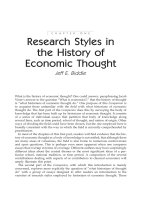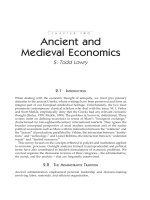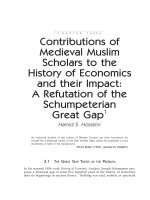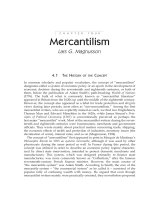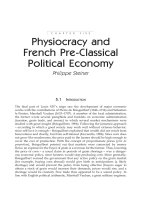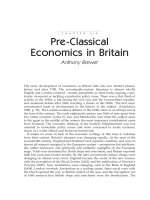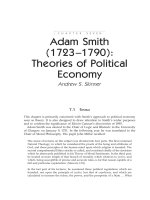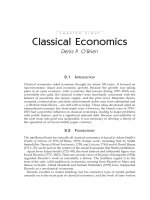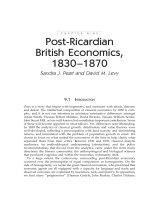A Companion to the History of Economic Thought - Chapter 15 doc
Bạn đang xem bản rút gọn của tài liệu. Xem và tải ngay bản đầy đủ của tài liệu tại đây (199.08 KB, 15 trang )
AMERICAN ECONOMICS TO 1900 231
CHAPTER FIFTEEN
American Economics
to 1900
William J. Barber
15.1 INTRODUCTION
To judge by the distribution of Nobel Prizes in economics over the past three
decades or so, it would appear that American economics – for good or ill – has
come to occupy a position of world preeminence. This has not always been so. To
the contrary, if we roll the clock back to consider the “state of the art” during the
first century of the nation’s existence, the United States was largely on the
periphery of major intellectual developments in the discipline. Indeed, when
the country’s centennial was celebrated in 1876, American economists had an
inferiority complex. Writing on this occasion, Harvard’s Charles F. Dunbar – the
first American to be accorded the title of “Professor of Political Economy” –
observed that American scholarship as yet had contributed nothing to fundamental
economic knowledge. In his reading, American economics to date had been
derivative, stagnant, and sterile. He further held that most of the domestic
restatements of doctrines formulated abroad were flawed (Dunbar, 1876,
pp. 124–54). Foreign observers tended to echo this appraisal.
The question thus needed to be asked: What could account for the backward-
ness of American intellectual achievement in this discipline? Numerous answers
to this question were offered and each identified a pertinent aspect of the
national reality. Creative intellectual production, it was suggested, should not be
expected in an environment in which the challenge of taming a vast continent
was the primary claimant on energies. “Do-ers,” in other words, should not be
expected to be “thinkers.” The abundant resource endowment, so welcome in
other respects, might also account for an apparent lack of original thinking in
political economy. In the absence of perceived scarcity, stimuli to provoke hard-
nosed analyses were blunted. Properties of America’s federal system of govern-
ment might also account for the country’s seeming backwardness in economic
232 W. J. BARBER
analysis. Issues that deserved to be analyzed at the national level had been dis-
persed to the jealously guarded jurisdictions of individual states. This feature of
the polity obstructed analytic progress on such matters as banking and currency.
It could plausibly be argued as well that the politics of states’ rights stunted
detached reflection in debates over free trade versus protection, even though
tariffs were within the constitutional mandate of the federal government.
International realities – not just national ones – framed the context for American
political economy up to 1900. After all, those wishing to acquire insight into the
discipline did not need to rely on home production. They could look overseas
and import ideas ready made. Given the absence of copyright protection for
foreigners, it may even have been more cost-effective for American publishers to
pirate ideas in book form from abroad than to sponsor local authorship.
At the same time, there was always vigorous discourse on economic topics.
Certainly colonial America did not lack for it. There were lively exchanges in
public debates over such matters as the uses and abuses of paper money and
over the “Mother Country’s” practices in shaping colonial trade patterns. In the
run-up to the American Declaration of Independence, protests over Britain’s use
of its taxing powers gathered considerable momentum. Moreover, the “Founding
Fathers” in the first decades of the Republic had displayed a plenitude of ingenu-
ity in crafting the instruments of a Federal political order and in establishing
the credibility and creditworthiness of a novel form of government. Arguably,
nothing in all this activity would qualify as a contribution to systematic economic
analysis. Though a number of contemporary commentators took note of this
shortcoming, the age of the economic treatise was not born until 1820.
As befitted the sectional diversity of the country, the first generation of Amer-
icans to produce systematic treatises on political economy did not speak with
one voice. All of them, however, were obliged to come to grips with a common
set of questions. Were economic concepts designed in the “Old World” transferable
to the “New?” Should European formulations be rejected out of hand, or could they
be made serviceable with modifications? Or was an altogether different approach
to political economy called for in a young nation that had already severed its
political links with the Mother Country? A review of the ways in which a repre-
sentative sample of contributors responded will illustrate the variations played
on these themes.
15.2 THE PIONEERING NATIVE VOICE: DANIEL RAYMOND
(1786–1849)
The author of the first full-scale treatise produced on American soil, Daniel
Raymond, chose to issue a full-throated plea for a declaration of American
intellectual independence. His objective, as he put it in Thoughts on Political Economy
(published in 1820), was “to break loose from the fetters of foreign authority
– from foreign theories and systems of political economy, which from the dissim-
ilarity in the nature of governments, renders them altogether unsuited to our
country” (Raymond, 1820, pp. v–vi).
AMERICAN ECONOMICS TO 1900 233
These were high aspirations indeed. They were expressed by a man who had
decided to study the subject in order to relieve boredom as an under-employed
lawyer in Baltimore. Persuaded that the absence of an American treatise on political
economy was a “reproach to the nation,” he persisted in his endeavor. Raymond
mounted a frontal attack on core propositions that Adam Smith had advanced in
the Wealth of Nations. The nation, in Raymond’s view, should be understood as
an organic “unity” which transcended the aggregate of its individual members.
This conception suggested that the public interest and private interests might
diverge. Optimal growth in national wealth – which he defined as the “capacity for
acquiring the necessaries and comforts of life” – required guidance from above. He
further charged Smith with error in the importance assigned to “parsimony” to
fuel “accumulation.” To the contrary, Raymond held that consumption was the
force driving expansion in productive capacity. From that point of view, emphasis
on saving invited disaster. The “present distress of our country,” Raymond wrote,
arose entirely from “the circumstance that consumption does not equal pro-
duction.” This led to “surplus” in the form of unsold output, which depressed
economic activity. It was the duty of the legislator “to make provision . . . for its
immediate consumption” (Raymond, 1820, p. 55). The measures that Raymond
had in mind were shelters for home enterprise from foreign competition and
spending on public works. For Raymond, “full employment” – and he used that
expression – deserved top priority. That goal could be achieved if the informed
legislator intervened to push production to the limits of its potential. The workings
of an invisible hand could not be trusted to produce that result.
15.3 MUTATED CLASSICISM IN TEXTBOOK LITERATURE: THE CASE OF
THE
REVEREND FRANCIS WAYLAND (1796–1865)
Imported ideas got a more appreciative hearing from the first cohort of Amer-
icans authoring textbooks in political economy than they did from Raymond. The
conditions of their production were such that more respectful references to learned
authorities seemed appropriate. In the early American colleges, it was standard
practice for the president – who, in the denominationally linked institutions,
was invariably a clergyman – to lecture to seniors on “moral philosophy.” The
Reverend Francis Wayland, author of the most widely read work on political
economy before the Civil War, came to the topic via this route. His Elements of
Political Economy, first published in 1837, was a codification of lectures he had
prepared in connection with his presidential duties at Brown University in Rhode
Island. Wayland’s approach to the subject matter was heavily influenced by his
background as a clergyman. Within his perspective, the “invisible hand” should
be understood as the “Divine hand.”
Wayland drew heavily on the later classical tradition, as transmitted primarily
by J B. Say and J. R. McCulloch. He accepted fully its conclusions about the bene-
ficence of free markets and the wisdom of careful limits on governmental partici-
pation in economic activity. But his message was not just a clone of the European
originals. On a number of significant points, he re-wrote standard doctrine.
234 W. J. BARBER
His adaptation of European thought to the American environment banished later
classicism’s preoccupation with the dismal prospects associated with the approach
of the stationary state. This outcome seemed inapplicable in the United States,
where land scarcity posed no threat and the Malthusian population devil was
nowhere in evidence. Classical teaching on the “unproductiveness” of labor in the
services sector also required revision: those “laborers” engaged in the “industry of
discovery and investigation” created knowledge that advanced the welfare of the
community and were, therefore, productive. Ricardo’s account of rent as flowing
exclusively from the “natural and indestructible powers of the soil” was particu-
larly objectionable. Rents were also determined by the attractiveness of land for
commercial, industrial, and residential purposes. In addition, the Ricardian account
of agricultural development – which presupposed that cultivation began on high-
fertility acreages and was subsequently extended to inferior ones – was out of touch
with the reality of America’s westward expansion (Wayland, 1838, passim).
Imported ideas could thus provide an organizational frame for economic dis-
course. But when adapted to the perceived structural “facts” of the American
economy and adjusted for ideological compatibility with the dominant religious
tradition, much in the originals dropped out in translation. America offered the
promise of a happy future in which uninterrupted progress and social harmony
could prevail.
15.4 A RENEWED CALL FOR IMPORT REJECTION:
THE CONTRIBUTION OF HENRY C. CAREY (1793–1879)
While bowdlerized versions of European classicism formed the orthodoxy in
academic instruction, a vigorous statement of heterodoxy flowed from the pen of
Philadelphia’s Henry C. Carey. His central message amounted to an appeal for a
“new” American approach to the economic process in which tariff shelter for
home industries played a strategic role. When setting out his views, he took
sharp aim at Malthus and Ricardo. This was a step beyond Raymond, who had
focused on Smith and had ignored Ricardo. For Carey, Malthusian teaching on
the causal linkage between population growth and subsistence wages was
misguided. To refute it, he introduced a “principle of association” which held
that enlarged populations – when concentrated geographically – promoted the
division of labor, raised productivity, and brought benefits to all. The concept of
“diminishing returns” should thus be replaced by one of “increasing returns.”
The Ricardian rent theory was also wrong. Carey asserted that extension of the
cultivated area had proceeded historically from the inferior to the superior lands
– the reverse of the Ricardian sequencing. Although he gave too much weight to
this alleged “fact,” his essential argument on this point was that productivity in
agriculture could expand through time as a result of technological improvements
and gains in labor efficiency. Clustering the manufacturing and agricultural sectors
would generate mutually reinforcing growth and bring this result to pass.
The desired outcome, however, could not be accomplished under a regime of
free international trade. In Carey’s opinion, that position amounted to nothing
AMERICAN ECONOMICS TO 1900 235
less than a British conspiracy to lock the American economy (and much of the
rest of the world, for that matter) into the dependent status of a primary producer.
Not only did this suppress economic advance; it tended also to contaminate
the “New World” with the class conflicts of the “Old World.” The class divisions
that had provided the organizing categories of Ricardian economics should
have no place on the American continent. Instead, a “harmony of interests”
should prevail. But it would have to be contrived through policy intervention to
promote balanced expansion of industry and agriculture.
Carey was the first American to attract much attention abroad. Lots of it was
unflattering. John Stuart Mill, for example, saw fit to denounce his muddles in
his Principles (Mill, 1848, pp. 181–3, 922–5) and Marx attacked him as a “naive
harmonizer” in Das Kapital (Marx, 1867, p. 563). In Germany, on the other hand,
translations of his works found sympathetic audiences, aided in part by Friedrich
List’s efforts in promoting them. At the minimum, Carey did something to
reduce America’s trade deficit in the international traffic in economic ideas.
15.5 THE “PECULIAR INSTITUTION” AS PART OF THE NATIONAL
REALITY BEFORE THE CIVIL WAR
American writers assigned high priority to social harmony and typically held
that the United States offered unique opportunities for its realization. The institu-
tion of slavery in the Southern states meant, however, that American society had
a fundamental disharmony imbedded in its very structure. To what extent, then,
did this national reality influence American political economy in the first half
of the nineteenth century? Whether one regarded the “peculiar institution” as
malignant or benign, its existence was the overarching issue in political discourse
prior to the Civil War.
Among authors of works on political economy, many who regarded slavery as
repugnant chose to exclude it from their central purview, treating it instead as a
moral and legal question. Wayland, for example, adopted this posture. He was
not blind to abuses within the system, but argued that they should be corrected
by uplifting the moral character of masters and slaves alike. Nor did he support
proposals that Congress should legislate slavery out of existence. In his view, the
federal government had no constitutional authority to do so: disposition of this
matter properly belonged to the respective states.
Others insisted that slavery had to be dealt with head-on in American political
economy. Raymond, for example, took this position, writing that “an American
treatise would be very imperfect” if it “should omit so important a subject”
(Raymond, 1820, p. 438). In his judgment, the slave system had a significant –
and negative – impact on the growth of national wealth because it artificially
suppressed the potential contribution of labor to production. This institution
bred a mind-set in the South that encouraged laziness in its white population
and also compromised labor efficiency among blacks. Raymond regarded the
“peculiar institution” as a national blight and held that its elimination would
remove a brake on economic progress.
236 W. J. BARBER
Carey was even more outspoken in denouncing slavery and in insisting that its
discussion belonged within the sphere of economic analysis. His approach was totally
in character. The British commercial system, he maintained, was responsible for
slavery’s survival in the United States. Free trade had locked the South into an eco-
nomic structure based on cheap labor to produce primary commodities for export.
This evil could be remedied if Carey’s “national system” were adopted. A climate
of economic expansion – nurtured by protection to support the coordinated devel-
opment of farm and factory – would raise the demand for labor. And, as he put it,
“when two masters seek one laborer, the latter becomes free” (Carey, 1853, p. 303).
Slavery as a distinctive feature of the national reality conditioned the flow of
American political economy in yet other ways. In the early decades of the nineteenth
century, a number of Southern states were in the vanguard of the country’s
intellectual life. Largely immune from the theological correctness that was super-
imposed on political economy as presented in the Northeast, they had easier access
to avant-garde European thought. This was particularly noteworthy in the 1820s
in Jefferson’s Virginia and in the state of South Carolina, where Thomas Cooper
(1759–1839) and Jacob Nunez Cardozo (1786–1873) produced defenses of free
trade, argued on Ricardian lines. The promising sparks in Southern political
economy were soon snuffed out. Creative thinkers who could not subscribe to
the regional “orthodoxy” on slavery were silenced or departed for more congenial
surroundings. Those who accepted the “orthodoxy” dissipated intellectual energies
in their attempts to defend the “peculiar institution.”
15.6 A SPECIAL CASE OF ANALYTIC ORIGINALITY
While Americans conspicuously lagged Western Europeans in the creation of
analytic breakthroughs, the environment of the New World was not inherently
hostile to conceptual innovation in economics. A genuinely original advance in
economic theorizing was published in Boston in 1834 under the title Statement
of Some New Principles on the Subject of Political Economy, Exposing the Fallacies of
the System of Free Trade, and of Some Other Doctrines Maintained in “The Wealth of
Nations.” The author, John Rae (1796–1872), was a Scotsman who had emigrated
to Canada in 1822, where he found employment as a schoolmaster. As far as
political economy was concerned, he was largely self-taught (though he had
taken a degree at the University of Aberdeen and had studied medicine for
several years at the University of Edinburgh). Despite the subtitle of his major
work, the book was not a militantly protectionist tract. To the contrary, the quali-
fications to Adam Smith’s case for free trade were argued primarily on “infant
industry” grounds. From Rae’s perspective, the “legislator” had a positive role to
play in shaping policies to promote capital accumulation and to provide a cli-
mate favorable to economic progress. These conclusions emerged in the context
of his inquiry into the “laws” regulating the increase or diminution of “wealth”
in various nations of the world. Rae’s agenda was clearly congruent with the
spirit of classical economics in the tradition of Smith. What made Rae’s position
distinctive was the way he explained the process of capital accumulation.
AMERICAN ECONOMICS TO 1900 237
Rae clearly broke new ground when analyzing the conditions that influenced
“the effective desire of accumulation.” An analogous conception in mainstream
classical economics held accumulation to be primarily a function of saving aris-
ing from the profits of a capitalist class. Rae instead argued that the strength or
weakness of the accumulative principle involved questions of intertemporal choice
in which decisions about sacrificing present goods for future ones were heavily
conditioned by social and cultural conditions. The moral of this part of the tale
was that a society in which the accumulative principle was strong would create
more capital instruments – and would thus grow faster – than one in which the
accumulative principle was weak. In support of this proposition, he drew – among
other things – on his observations of conditions in the New World. Much of the
explanation of the apparent poverty of North American Indian tribes – and, he
added, of Asians and Africans in general – could be traced to the weakness of the
accumulative principle in their cultures. The condition of the accumulating soci-
eties (e.g., Britain, Holland, and Western Europe more generally) stood in marked
contrast.
Rae’s analysis identified the conceptual core of what would later become the
accepted neoclassical theory of interest. This aspect of his thought left no mark
in his lifetime and had to be rediscovered a quarter-century after his death.
Although it is a bit of a stretch to count Rae as a contributor to American eco-
nomics, his example at least demonstrates that valuable and fundamental economic
ideas could germinate in the soil of the New World, despite the fact that they
went unappreciated by his contemporaries.
15.7 THE LANDSCAPE OF THE LATE NINETEENTH CENTURY
After the Civil War, the contours of political economy in America shifted. Slavery
was off the national agenda. The new threat to social harmony came from other
directions. As the country moved into a mature phase of industrialization, strife
between capital and labor took ugly turns. New questions emerged about both
the efficiency and the fairness of a market system increasingly dominated by
“bigness.” Meanwhile, some lingering issues concerning the functioning of the
nation’s money and credit system, as well as America’s place in the international
monetary order, awaited resolution. Meanwhile, a long-standing controversy
between advocates of free trade and advocates of protection had taken on an
added dimension of complexity. As a central part of its program to finance mobil-
ization during the Civil War, the Federal government had raised tariff schedules
to unprecedented heights and the beneficiaries of that policy were determined to
resist reductions in the shelters they had come to enjoy.
The events of the Civil War had bred a new consciousness about the potential
of tooled knowledge to ameliorate social and economic problems. This sentiment
motivated the creation of an American Social Science Association (ASSA) in 1865.
This Boston-based organization was inspired in the post-bellum flush of enthusi-
asm for social reforms. Its organizers charted an ambitious program. As they set
out the Association’s overall purpose in the Constitution:
238 W. J. BARBER
Its objects are, to aid the development of Social Science, and to guide the public
mind to the best practical means of promoting the Amendment of Laws, the
Advancement of Education, the Prevention or Repression of Crime, the Reformation
of Criminals, and the Progress of Public Morality, the Adoption of Sanitary Regula-
tions, and the diffusion of sound principles on questions of Economy, Trade, and
Finance. (As quoted in Haskell, 1977, p. 161)
It was presupposed here that the collection and dissemination of facts on social
and economic conditions would be sufficient to mobilize the public behind
remedies for perceived ills. In the vernacular of the time, investigation should be
accompanied by agitation and then by action. This initiative, it is worth noting,
was applauded by the leading British economist of the day. In correspondence
with the officers of the ASSA (who had invited him to be their guest in the
United States), John Stuart Mill remarked:
What you say about the new start which the mind of America has been led to make
by her long and arduous struggle, is exactly what I foresaw from almost the very
beginning. I wrote in January, 1862, and often said in the years following, that if the
war lasted long enough, it would very likely regenerate the American people, and
I have been seeing more and more clearly since it closed, that to a considerable
extent it has really done so, and in particular, that reason and right feeling on any
public subject has a better chance of being favorably listened to, and of finding the
national mind open to comprehend it, than at any previous time in American history.
(Mill, 1870)
The post-bellum climate had clearly generated a substantially increased
demand for expertise to guide the shaping of economic and social policies. Indeed,
the ASSA took as part of its charge to investigate such topics as pauperism,
the “relation of employers and employed,” hours of labor, the national debt, tariffs
and taxation, the control of markets, the value of gold, and “all questions
connected with the currency.” But there was a bottleneck on the supply side: the
country then lacked a cadre of trained personnel equipped to deal dispassion-
ately with these issues. And this, in turn, frustrated the ASSA’s capacity to carry
out its mission. The backgrounds of the few whom the organization identified
to conduct economic studies will illustrate the nature of the problem. David A.
Wells (1828–98), who was called to head one of ASSA’s investigative depart-
ments, had moved from a prewar career as a successful author and distributor of
scientific manuals – during which he had identified himself with Carey’s brand
of protectionism – to an appointment in 1866 as Commissioner of the Revenue in
the Federal government. His experience in that post had convinced him that the
wartime fiscal policy built around high tariffs had bred serious inefficiencies in
the country’s manufacturing sector and he then became one of the nation’s most
uncompromising champions of free trade. (Wells was to acquire a considerable
international reputation: his various honors included election by the French
Academy to the seat vacated by the death of John Stuart Mill.)
By 1874, the ASSA had managed to attract two men with professorial titles –
William Graham Sumner (1840–1910) and Francis Amasa Walker (1840–97), both
AMERICAN ECONOMICS TO 1900 239
of Yale – to assist in its work. In view of the fact that academic appointments for
specialists in political economy were then a rarity, this was noteworthy. Sumner’s
call to such a position was virtually by accident: he had been trained as a clergy-
man and had been brought to Yale because a newly installed president had
deputized him to deliver the custom-honored lectures to seniors on political
economy/moral philosophy. Once there, Sumner became one of the nation’s
most outspoken advocates of a Spencerian version of Social Darwinism. Walker
(whose father had written a political economy textbook that sustained the tradi-
tion launched by the Reverend Francis Wayland) thus had an in-house exposure
to the subject matter, but he also brought other qualities to the table: he had
served as superintendent of 1870 Federal census (a job he was to repeat in 1880)
and he had reached general officer rank in the Union Army at the prodigiously
young age of 25.
Over time, the pool of competence in political economy was to grow. In the
1870s, three American institutions awarded a total of three doctorates in political
economy; the decade of the 1880s saw the award of 11 such degrees by five
institutions. But there was still a scarcity of home-grown Ph.D.’s. The major
suppliers of advanced work in political economy to young Americans were the
universities in Germany, to which they migrated in considerable numbers.
The “Germanization” of a significant body of recruits to political economy was
to have formidable consequences. In the first instance, it sharpened a divide that
was already latent among those engaged in serious work on economic issues.
Those with a German exposure tended to identify themselves as members of a
“new school.” As the more militant among them saw matters, the methods and
the conclusions of an “old school” that had looked to English political economy
for inspiration should be denounced. Deductive reasoning in economics was
held to be suspect: proper procedure called instead for direct empirical investiga-
tion of economic reality. Similarly, the notion that economic “laws” could be
identified – ones with universal validity throughout time and space – needed to
be purged. No less important in the “new school” program was rejection of the
“old school’s” veneration of laissez-faire. The message that instead should be
conveyed was that state intervention could make a constructive contribution to
economic improvement. The mid-1880s witnessed escalation in the rhetorical
warfare between members of these rival camps. This meant, in turn, that possession
of an advanced degree in political economy was not itself an adequate badge of
professional identification. One needed to inquire further into the particular
“school” to which an aspiring professional belonged.
15.8 “NEW SCHOOLERS” VERSUS “OLD SCHOOLERS”
IN THE 1880S
The battle lines between the rivals in the American Methodenstreit of the 1880s
were sharply drawn at the Johns Hopkins University, an institution founded in
1874 with the primary charge to compete with German universities (and all
other comers, for that matter) in the production of graduate students with
240 W. J. BARBER
doctoral degrees in the liberal arts and sciences. Two strong personalities with
interests in political economy were on the scene there. Simon Newcomb (1835–
1919), an astronomer–mathematician economist, occupied a professorial chair
in mathematics. He was a man with a flair for abstract model-building, whose
wide-ranging interests included formulation of a sophisticated version of the
quantity theory of money. His hostility toward governmental intervention
in economic affairs had made him a natural leader of the “old school.” Richard
T. Ely (1854–1943), with a doctorate from the University of Heidelberg, held an
appointment as an associate in political economy, an untenured position. Writing
from the German historical perspective, he regarded himself as in the vanguard
of the “new school” and called for the scholar to be actively engaged in setting
the world to rights.
Hostilities between these two went public in 1884. Ely fired the opening salvo
in an essay that attacked the sterility of the methods of the “English” school. He
asserted that “mathematico-economic works” represented “a not very successful
attempt to develop further the older abstract political economy” and that “works
which have advocated the application of mathematics to economics form no
essential part of the development of economic literature” (Ely, 1884, pp. 5–64).
Newcomb’s ire was aroused and he asked Daniel Coit Gilman, President of
Johns Hopkins, for “an opportunity to say a few words about your department
of political economy before the impulse which has been given me by Dr. Ely’s
pamphlet entirely dies out. It looks a little incongruous to see so sweeping and
wholesale an attack upon the introduction of any rational or scientific method
in economics come from a university whose other specialties have tended in
the opposite direction” (Newcomb, 1884a). Newcomb indicted Ely’s position
in print in November 1884, characterizing Ely’s work as an example of funda-
mental intellectual confusion and as an “irrational” proceeding (Newcomb, 1884b,
pp. 291–301).
The two men re-aired their differences publicly in 1886 in Science, the journal of
the American Association for the Advancement of Science. (It should be noted
that the American Association for the Advancement of Science – following the
lead of its British counterpart – created a section on Economic Science and Statis-
tics that became operational in 1882.) Ely and Newcomb then restated familiar
positions. Ely maintained that concern with what ought to be was inherent in
the work of the political economist; that economists should seek to understand
the “laws of Progress” and to show how they could be directed to promote the
economic and social growth of mankind; and that the ethical ideal was “simply
the Christian doctrine of talents committed to men, all to be improved” (Ely,
1886, pp. 529–33). Newcomb, on the other hand, maintained that it was a “contra-
diction in terms” to regard discussion of what should be as “science”; that the
principle of “noninterference” in economic affairs also favored progress, but sought
its achievement by giving individuals the widest possible latitude for choice;
and that public intervention was suspect because governments were incapable
of acting on “sound business principles” (Newcomb, 1886a, pp. 538–42). In an
unsigned review of Ely’s book, The Labor Movement in America (1886), Newcomb
was even more outspoken in his denunciation of Ely’s work, saying it displayed
AMERICAN ECONOMICS TO 1900 241
a “lack of logical acumen” and an “intensity of bias.” Newcomb concluded with
the following comment: “Dr. Ely seems to us to be seriously out of place in a
university chair” (Newcomb, 1886b, pp. 293–94). Newcomb also informed Gilman
privately of his negative appraisal of Ely’s competence, advising him that “very
little attention [was] paid to the analytic process” in Ely’s teaching at Johns
Hopkins (Newcomb, 1886d). After observing the performance of Ely’s graduate
students (whom he had been asked to examine in May 1886), Newcomb reported
that “the main teaching seems to have been directed toward the administrative
and economic policies of the leading countries of the world, especially Germany.”
In Newcomb’s judgment, “the candidates showed an almost deplorable want of
training in the power of logical analysis of the economic theories that move men
and determine the course of our industry at the present time . . . [T]hey were
amply able to grapple with the subject, had it only been presented to them, but
that was quite new to their minds” (Newcomb, 1886c).
There could be no common ground between these positions in the Methodenstreit
of the 1880s. “New school” advocates indicted members of the “old school” as
“immoral,” and “old schoolers” treated the “new school’s” protagonists as “incom-
petent” and “unscientific.” More was at stake here than just the outcome of a
methodological dispute. For the “new schoolers” particularly, jobs also mattered.
Most in their ranks were not yet in established careers. Given their sympathies
for the rights of workers, they were in an exposed position at a time when public
opinion was agitated about the threat to the social order posed by violent strikes.
These considerations influenced the timing of the formation of the American
Economic Association in 1885. Ely seized the initiative in this matter by calling
on the like-minded to join an organization that would be explicitly committed to
combating the influence of “the Sumner, Newcomb crowd.” Part of this effort
represented an attempt on the part of “new schoolers” to strengthen their hand
by consolidation, thereby reducing their vulnerability in the academic labor
market. Ely also had a further objective in mind. The initiation of national scho-
larly organizations was an activity looked upon with favor by the administration
at Johns Hopkins, and he had reason to believe that his involvement with AEA
would bolster his quest for a permanent position there. (With regard to this
expectation, he was disappointed and he moved to the University of Wisconsin
in 1892.) It should be noted the AEA was not conceived of as a conventional
scholarly body. On the contrary, it was designed as a vehicle to promote the
“new school” program. This was apparent in the platform that Ely drafted for it,
which advanced the following propositions: “we regard the state as an educa-
tional and ethical agency whose positive aid is an indispensable condition of
human progress . . . (W)e hold that the doctrine of laissez faire is unsafe in politics
and unsound in morals . . . We do not accept the final statements which charac-
terized the political economy of a past generation . . . We hold that the conflict of
labor and capital has brought to the front a vast number of social problems
whose solution is impossible without the united efforts of church, state and
science” (Ely, 1885; as reprinted in Ely, 1938, p. 163).
Meanwhile – despite the distractions created by the internecine warfare between
the rival camps – some interesting substantive research was being conducted
242 W. J. BARBER
and finding an outlet. The AEA’s initial activities included the sponsorship of
a monograph series that published a memorable study, “The relation of the
modern municipality to the gas supply,” by “new schooler” Edmund J. James
(1855–1925), in which he set out the case for public ownership of a natural
monopoly. Another “new schooler,” Henry Carter Adams (1851–1921), examined
“The relation of the state to industrial action,” in which he developed criteria
for state intervention developed around the conception of industries subject to
increasing, decreasing, and constant returns. In a book-length study, Yale’s Arthur
T. Hadley (1856–1930) – another veteran of the German postgraduate experience,
but not a “new schooler” – produced an analysis of the railway industry which
contained one of the first demonstrations that firms may operate at a loss so long
as variable costs are covered. In 1884, Francis Amasa Walker – who was shortly
to serve as the first president of the AEA, a post he held from 1885 to 1892 –
published the first edition of a textbook that was to set the standard for the next
decade.
15.9 THE FALL-OUT FROM THE AMERICAN METHODENSTREIT
The Methodenstreit was to leave a formidable mark on the subsequent flow of
American economics. By the mid-1890s, economists on both sides of the barri-
cades in the preceding decade concluded that it would be opportune to mute
their differences. Further blood-letting – at least in public – would be unseemly
and counterproductive. Economists of all persuasions were then eager to claim
standing as “professionals,” not least because they wished to solidify a secure
position for the discipline in the expanding university system. This change in the
climate was reflected in the restructuring of the American Economic Association.
The polarizing language of Ely’s original platform was expunged and Ely him-
self was removed from high office in the Association. By 1894, even Newcomb
had seen fit to join the AEA, though Sumner continued to reject all invitations.
The success of some amateurs in capturing the popular imagination added
urgency to this regrouping. To the aspiring professionals, it was humiliating when
the untutored could move the public. Two examples merit attention. Henry George
(1839–97), a journalist with only an elementary education, was particularly
effective in mobilizing opinion. His Progress and Poverty, first issued in 1879,
became a bestseller. There was an unmistakable native-soil quality to this work:
George had been inspired to write it by his experience in California, where he
had observed overnight fortunes created from the appreciation in land values as
its territory was being rapidly settled. The “monopoly power” conveyed by pri-
vate ownership of land, he concluded, was the root of all evil: unearned rents
distorted income distribution and land speculation idled productive resources.
The remedy was a “single tax” through which the state would appropriate these
ill-gotten gains. Less significant – but still embarrassing – was the work of William
Harvey (1851–1936), a lawyer, sometime silver miner, and subsequently a
publisher in Chicago. His Coin’s Financial School, published at the height of
the highly charged national debate over bimetallism in the 1890s, insisted that
AMERICAN ECONOMICS TO 1900 243
permanent prosperity would be assured through free coinage of silver at a
silver–gold ratio of 16 to 1. Harvey added liveliness to his argument by depicting
an imaginary debate, in which a small child confounded a learned economist
with the cogency of his case for a crude quantity theory of money. Altogether, it
behooved the professionals to bury their differences and to defend common
ground against “quacks.”
Meanwhile, a number of subtle – but significant – shifts in position were occur-
ring within the ranks of the professionals, particularly among those who had cut
their teeth in the “new school.” John Bates Clark (1847–1938), for example, had
begun his career sympathetic to the ethical component of “new school” doctrine.
His interest in the linkage between economics and ethics did not waver. By the
mid-1890s, model-building could now be seen as having an essential role to play
in understanding the “ethics” of income distribution. This consideration inspired
his innovative contributions to marginal productivity theory which, in turn, won
him a reputation as the first American to produce pure theory of world-class
quality.
Ely’s work also took a different turn. His interest in championing causes per-
sisted. But he, in company with many who had joined his movement, was obliged
to rethink the early enthusiasm for governmental intervention. An awkward
national reality – one that sharply separated the United States from Germany –
had to be faced squarely. America lacked a cadre of professional civil servants
competent to administer an enlarged program of public regulation. Under the
American “spoils system,” expansion in the jurisdiction of the state would
simply fatten the wallets of corruptible politicians. It is not in the least surprising
that Ely chose to channel part of his abundant energy to lobbying for a merit
system in the civil service, or that he regarded the School of Economics, Political
Science and History which he built at the University of Wisconsin as a training
ground for future civil servants.
Simultaneously, there were further signs of fundamental changes on the Amer-
ican economics scene. By the mid-1890s, some impressively able home-grown
talents – that is, those who had studied the discipline entirely in the United States
and who were thus innocent of direct exposure to doctrines espoused in foreign
universities – had begun to emerge. The career of Irving Fisher (1867–1947) is a
notable case in point. He obtained his undergraduate and graduate training at
a single institution: Yale University. His doctoral dissertation – entitled Mathemat-
ical Investigations in the Theory of Value and Prices, and completed in 1891 – was a
pioneering statement in mathematical economics and was to be recognized as a
classic in that genre. In his subsequent career, Fisher went on to make interna-
tionally applauded original contributions to the theory of capital and interest, to
monetary theory and policy, and to the theory and practice of index-number
making.
The intellectual momentum of the 1890s also generated a reorientation toward
another aspect of the original “new school” program: that is, its doubts about the
usefulness of deductive theorizing. The skepticism lived on, but it found expres-
sion in other ways. Some of those who turned their backs on abstract theory elected
to concentrate on the collection and analysis of statistical data. Empirical work of
244 W. J. BARBER
this type had been going on quietly for some time, building on foundations
painstakingly laid through Francis Amasa Walker’s liaison with the Federal
Bureau of the Census. This line of investigation was now invigorated. Others
sought to enrich the discipline through direct observation of the economic beha-
vior of living people. John R. Commons (1862–1945), for example, began to move
inquiry in that direction with his studies of the circumstances of workers. What
came through was the finding that the labor movement in America was structured
by “group consciousness,” not “class consciousness.” When the implications of
that insight were assimilated, they helped to blunt the impact of another doctrine
– namely, Marxism – that was available on the import market.
The 1890s also spawned a home-grown strain of radicalism in academic
economics. Thorstein Veblen (1857–1929) picked up one of the threads of the
“new school” – its disdain for model-building organized around a priori assump-
tions about human behavior. His idiosyncratic critique of marginalism placed
him far outside the mainstream, yet his voice was surely that of an authentic
American original. The practical impact of his message was delayed until the
1930s, when a group of “planners” inspired by his teaching acquired influential
governmental positions. Had it not been for the tolerance for diversity condi-
tioned by the fallout from the Methodenstreit, it is an open question whether or
not Veblen would have been able to support himself adequately to press his
ideas forward.
15.10 FIN DE SIÈCLE ASSESSMENTS
By 1900, American economics had moved a long way from where it began. This
reflected transformations in the structure of the economy, as well as changes in
the character of the international marketplace for economic ideas (and America’s
position within it). In the early going, American political economy had been
heavily import-dependent, even though foreign ideas were altered to adjust
their fit to circumstances in the “New World.” Domestic production – though
sometimes strident in its assertions of originality – was then viewed by most of
the rest of the world as naive and unsophisticated.
It is perhaps ironic that the Methodenstreit of the 1880s – which began as a
confrontation between advocates of German and British doctrines – should have
given birth to a variety of new departures with clear American markings. No
longer could American economics be dismissed as retarded. There was dynamism
aplenty. A striking component of the new national reality was its very openness to
pluralism.
By the close of the nineteenth century, the United States was about to become
a net exporter of economic ideas. This reversal of fortunes had begun to catch the
attention of perceptive foreign observers. Writing in 1898, Britain’s Alfred Marshall,
for example, observed: “. . . there are many signs that America is on the way to
take the same leading position in economic thought, that she has already taken
in economic practice.” (Marshall, 1961 [1898], vol. II, pp. 760–1). This was quite a
different note from the one Americans themselves had sounded in 1876.
AMERICAN ECONOMICS TO 1900 245
Note
This chapter draws heavily on two earlier essays by the author: “The position of the
United States in the international marketplace for economic ideas (1776–1900),” in M.
Albertone and A. Masoero (eds.), Political Economy and National Realities, Fondazione Luigi
Einaudi, Torino, 1994, and “Economists and professional organizations in pre-World War
I America,” in M. M. Augello and M. E. L. Guidi (eds.), The Spread of Political Economy and
the Professionalisation of Economics, Routledge, London, 2001.
Bibliography
Carey, H. C. 1853: The Slave Trade, Domestic and Foreign: Why It Exists and How It May Be
Extinguished. Philadelphia, PA: A. Hart.
Dunbar, C. F. 1876: Economic science in America, 1776–1876. North American Review, CXXII
(January), 124–54.
Ely, R. T. 1884: The past and present of political economy. Johns Hopkins University Studies
in Historical and Political Science, II, 5–64.
—— 1885: Platform of the American Economic Association. As reprinted in Ely, R. T. 1938:
Ground Under Our Feet: An Autobiography. New York: Macmillan.
—— 1886: Ethics and economics. Science, VII, June 11, 529–33.
Haskell, T. L. 1977: The Emergence of Professional Social Science: The American Social Science
Association and the Nineteenth Century Crisis of Authority. Urbana, IL: University of
Illinois Press.
Marshall, A. 1961 [1898]: Principles of Economics, 9th (variorum) edn., vols. I and II. Lon-
don: Macmillan.
Marx, K. 1967 [1867]: Capital, vol. I. New York: International.
Mill, J. S. 1926 [1848]: Principles of Political Economy, ed. W. J. Ashley. London: Longmans,
Green.
—— 1874 [1870]: Letter dated 1870, published in The Journal of Social Science, V.
Newcomb, S. 1884a: Letter to President Gilman, May 14. Gilman Collection, Special
Collections, Milton S. Eisenhower Library, Johns Hopkins University.
—— 1884b: The two schools of political economy. The Princeton Review, LX (November),
291–301.
—— 1886a: Aspects of the economic discussion. Science, VII, June 18, 538–42.
—— 1886b: Dr. Ely and the Labor Movement. The Nation, XLIII, October 7, 293–4.
—— 1886c: Letter to President Gilman, May 24. Gilman Collection, Special Collections,
Milton S. Eisenhower Library, Johns Hopkins University.
—— 1886d: Letter to President Gilman, May 28. Gilman Collection, Special Collections,
Milton S. Eisenhower Library, Johns Hopkins University.
Raymond, D. 1820: Thoughts on Political Economy. Baltimore; Fielding Lucas, Jrs.
Wayland, F. 1838: The Elements of Political Economy, 2nd edn. Boston: Crocker and Brewster/
New York: Robinson and Franklin.

